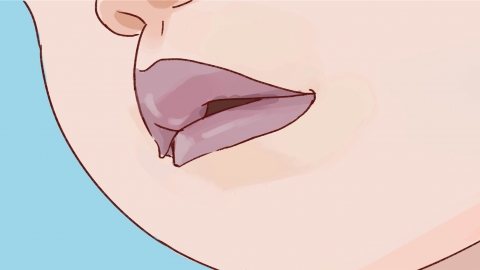What causes purple discoloration around the mouth, and what should be done?
Generally, cyanosis around the lips may be caused by hereditary factors, cold exposure, iron deficiency anemia, chronic obstructive pulmonary disease (COPD), respiratory failure, or other reasons. It is recommended to seek medical attention promptly and follow the guidance of a physician for appropriate treatments, such as general care and medication therapy. A detailed explanation is as follows:

1. Hereditary Factors
In some individuals, darker pigmentation around the lips may be due to genetic factors, but it typically does not accompany other health problems. No special prevention is generally required, although regular health checkups are recommended to monitor overall health.
2. Cold Exposure
In cold environments, the body conserves heat by constricting skin blood vessels to reduce heat loss, which may slow peripheral blood circulation. As a result, the lips may appear purple due to oxygen deficiency. It is important to keep warm, especially when going outdoors in cold weather; wearing a mask or scarf can help protect the face from cold winds.
3. Iron Deficiency Anemia
Iron deficiency anemia occurs due to insufficient iron intake or impaired absorption, leading to reduced hemoglobin synthesis. When hemoglobin's oxygen-carrying capacity declines, the lips may appear purple due to hypoxia. This condition may also be accompanied by pallor, fatigue, and other symptoms. Under a physician's guidance, medications such as ferrous sulfate compound granules, iron dextran tablets, and iron(II) fumarate tablets may be used for treatment.
4. Chronic Obstructive Pulmonary Disease
Chronic obstructive pulmonary disease is often associated with long-term smoking or inhalation of harmful particles or gases. It may cause airway obstruction and inadequate ventilation, leading to cyanosis of the lips. Symptoms may also include coughing and expectoration. Patients may use medications such as terbutaline sulfate tablets, acetylcysteine granules, and ipratropium bromide aerosol under medical supervision.
5. Respiratory Failure
Respiratory failure may result from severe impairment of ventilation and gas exchange functions in the lungs caused by airway obstructive diseases, lung tissue damage, or other conditions, leading to ineffective gas exchange and resulting in hypoxia combined with carbon dioxide retention. This can cause a series of physiological and metabolic disturbances. When respiratory function is compromised and oxygen supply is insufficient, the above symptoms may occur. Patients may also experience rapid breathing and difficulty breathing. Under a physician's advice, medications such as roxithromycin dispersible tablets, salbutamol sulfate tablets, and tiotropium bromide powder inhaler may be used for treatment.
Maintain healthy lifestyle habits, eat a balanced diet, avoid prolonged sun exposure, manage emotional well-being, and undergo regular health checkups.









